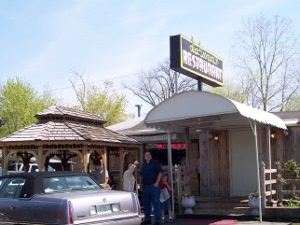 Billy Tripp's Mindfield
Billy Tripp's Mindfield
On the map, the drive from Memphis to Nashville seems short, but we made it last longer by taking winding back roads through forests and swamps, on roads where we often saw no other car but ours.
 Billy Tripp's Mindfield
Billy Tripp's Mindfield
Northeast of Brownsville, we stopped to photograph the local Major Art Work: Billy Tripp's Mindfield. This complex iron creation was begun several decades ago, the artist adding to it bit by bit. To our eyes it seemed as though it has been untouched for at least a few months, but it's hard to tell with iron! There is a bathtub suspended by cables, a defunct basketball hoop, some words and messages cut from slabs of metal; poles and post-hole diggers and scrap objects of various kinds are intertwined.
Just down the street was the other Brownsville landmark, a beautiful and beautifully maintained ante-bellum house. When we saw the sign "Boyd-Livingston-Tripp House" we realized why Brownsville has accepted this unconventional addition to their landscape.
Many of these little towns are still lively; at least, most of the county seats still seem to be prospering. The stores lining the courthouse square are occupied and open, houses are receiving fresh spring paint and landscape attention, and here and there a kitchen vegetable garden has been planted.
Farming in this part of the state appears to be mostly cotton and sorghum. Much of the land is either forested or under water -- nice for tourists  Downtown Franklin, Tennessee
like us but probably hard to work.
Downtown Franklin, Tennessee
like us but probably hard to work.
We have decided that we are at least as interested in finding places to walk as in seeing lots of the tourists sights, so instead of Opryland we decided to visit Historic Franklin, Tennesee. This small community is located about 30 miles south of Nashville. Avoiding the freeway allowed us to appreciate some of the ritziest housing we've seen this Spring. Estates of 30 and more acres were common, and the houses, most of them quite new, are immense.
Franklin is much more down to earth. It was established in 1799, and survived the Civil War even though at least one battle required several churches and the courthouse to be turned into hospitals for the duration. Today a number of houses dating from the early 1800s through the turn of the twentieth century have been identified, cleaned up, and form the basis of a walking and antique-shopping route.
We were looking for a map to the historic houses, but they are apparently between printings. Instead, after a friendly chat with a displaced  Dotson's Restaurant
Englishman now manning the visitors center, we received a map to the antique shops. It covered about the same area.
Dotson's Restaurant
Englishman now manning the visitors center, we received a map to the antique shops. It covered about the same area.
We thought we had uncovered a mystery or at least a scandal when we reached the public library only to find it locked with a sign on the door announcing that the library was moving, opening in December. An ominous poster said that the Book Sale Had been Cancelled due to Unforeseen Circumstances. Since this library building looked only about twenty years old (barely mature for library buildings) we wondered what had befallen it. But the mystery was solved when we arrived at the new location, a few blocks down the street, and found a much larger new edifice, which had indeed opened last December.
Exhausted by this detective work, we stopped for lunch at Dotson's Restaurant just at the edge of the Historic District, where we enjoyed some of the best restaurant food we've had in months: meat loaf, pulled pork barbecue, real creamed corn, real stewed tomatoes, and chess pie for dessert. Reasonable prices and friendly service, too! Not only do we recommend it, we have photographed it so travelers to the area can be sure not to miss it.